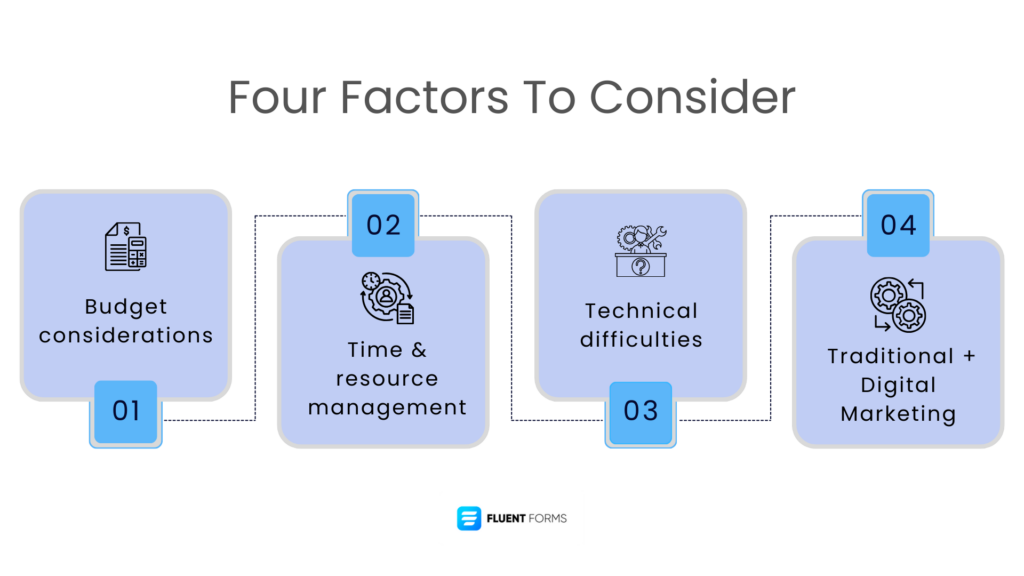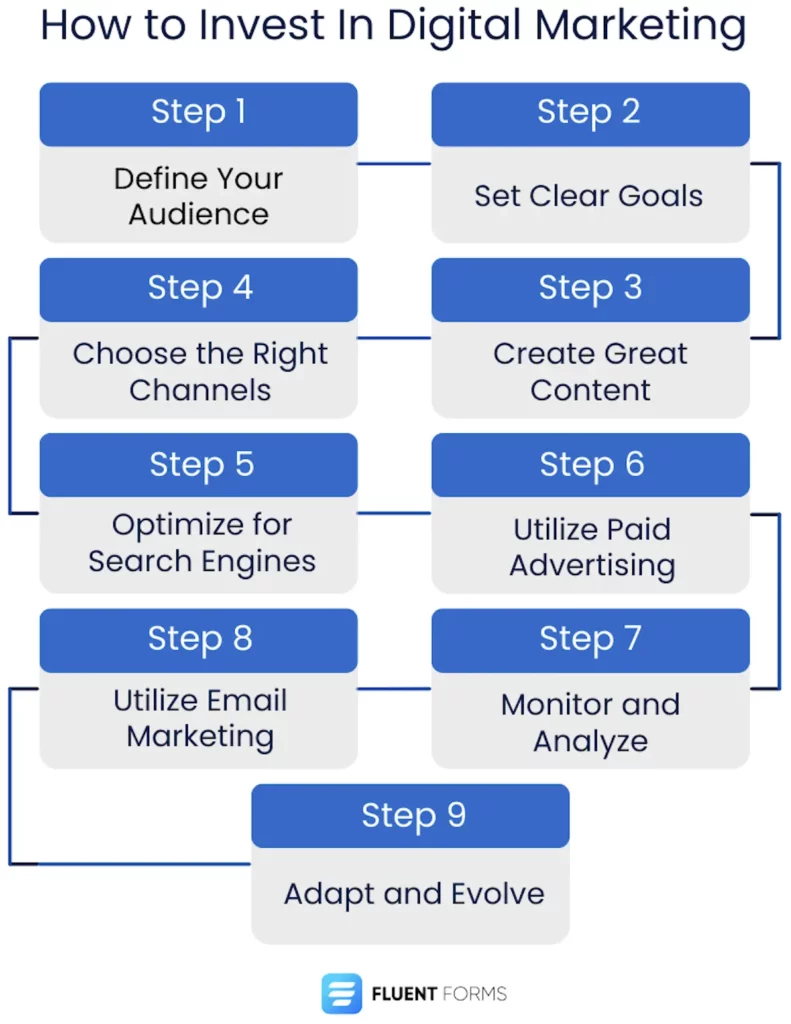Invest in Digital Marketing: 7 Reasons Why and How to Do It

Digital marketing is a term you’ve probably heard a lot, but it might still feel confusing, especially if you’re at the consideration stage of utilizing digital marketing for your business. Yes, the confusion is understandable.
But, look at the statistics– nearly 60% of small businesses use digital marketing, and the USA alone spends over $118.2 billion on digital ads. That’s huge, right?
So, it’s justified to say that if you have a scope, you should definitely invest in digital marketing, and surely it’s a smart move for any business.
In today’s blog, we are going to explain some solid reasons why you should consider investing in digital marketing and how to invest in digital marketing wisely.
Let’s dive in and make sense of it all together!
7 reasons to invest in digital marketing

Here are seven reasons why companies should invest in digital marketing to grow their business exponentially.
1. Reach potential customers worldwide
Digital marketing helps you break geographical barriers and allows your business to reach a global audience. Using different online platforms, you can sell your products or services to people from different parts of the world.
It helps you go beyond your limits; you can take your local business to the international level.
2. Gain more and still be cost-effective
Do you know why digital marketing outperforms traditional marketing? This is because it offers cost-effective yet efficient solutions.
While traditional marketing such as print media ads is often expensive, with online ads, social media, and email marketing you can deliver your targeted messages to a large audience group with a surprisingly low budget.
3. Acquire precious data and bullseye every time
Data is power! There’s no way you can deny the significance of data. When you invest in digital marketing, it will bring you valuable data and insights that will help your business to make informed decisions.
On the go, you will gain valuable data like your users’ behavior, preferences, engagement metrics, and more. These data allow you to continuously optimize, and adjust your marketing strategies and ensure higher return on investment (ROI).
4. Reach the right people at the right location
Suppose your business is based in the USA and you want to expand in the UK. While the UK is nearly 6 hours ahead of the USA, then how can you market your business in the UK? Well, digital marketing lets you do that without any hassle.
You can target the right audience at the right time at the right location. Through tools like Google Ads, and social media advertising channels, you can reach your desired people with specific demographics, interests, and behavior.
5. No latency, engage people in real-time
You don’t have to wait long to interact and reach your people and understand their responses. With digital marketing, you can engage with your audience in real-time. How? Social media and instant messaging tools make it possible.
Social media platforms are an integral part of any business for numerous reasons. You can address and solve customers’ pain points, and build a strong loyal customer base and more immediate connection with your audience.
6. Build brand and credibility on the go
Nowadays, there’s no way you can overlook a strong online presence to establish your brand values and credibility. Think of yourself buying something or dealing with any businesses, what would you check first? Their online presence and what people are saying about them. Right?
The same goes for your business too. People will search for your business online to check if you’re trustworthy or not. So, consistent messaging, positive customer reviews, and a lucrative online persona ultimately contribute to building trust and credibility among your target audience.
7. Have the flexibility to adjust harmoniously
Everything changes fast, but the digital landscape changes faster. However, digital marketing enables your business to adapt and adjust quickly to changes.
While traditional marketing fails to adapt to changes quickly, digital marketing lets you adjust campaigns based on real-time data or employ any emerging technologies promptly. You can have the flexibility to stay relevant in this fast-paced market.
We’ve discussed some obvious reasons why you should consider investing in digital marketing. We are also sure that if you dive into digital marketing, you will realize numerous benefits associated with this over time.
Okay, now this is the time to discuss how to invest in digital marketing. But before we go straight to the implementation process, we should consider some crucial facts that are discussed below.
Four strategic considerations before investing in digital marketing
Starting a new venture is both exciting and challenging at the same time, particularly when you encounter common objections and concerns. Here are some key considerations to address potential barriers and ensure a kickstart of your digital marketing transformation.

1. Budget considerations
If you don’t have much money, you can still boost your online presence. Make your website appear more on search engines by leveraging basic SEO practices. Use the right keywords, make useful content, and get links to your site. This way, more people can find your website without spending a lot of money.
You should explore cost-effective digital platforms like Facebook, Instagram, or LinkedIn for advertising. They allow you to run ads at certain groups and control your spending. Moreover, partner with influencers or businesses that are relevant to your industry to reach more people cost-effectively.
2. Time and resource management
To effectively manage your digital marketing efforts, prioritize and simplify the process. Find where your audience is online and focus on those channels. Plan your social posts ahead with a calendar to keep things consistent.
You can use automation tools to efficiently handle social media or emails to save time. Additionally, you can hire freelancers or agencies for jobs like creating content or designing graphics. This way, you save time and still get top-notch outcomes.
3. Technical difficulties
You don’t have to be a tech expert to do excellent in digital marketing. Lots of platforms are easy to use, and they have tools that really make sense. You can consider learning the basics from online resources and free courses on credible platforms like Google Digital Garage or HubSpot Academy.
There’s an alternative too. You can focus on your main business and think about hiring digital marketing experts or agencies. Certainly, they know their job and can create strategies that work for your business goals. This saves time and ensures that your digital marketing is successful. However, we still suggest you explore some fundamentals from the above-mentioned platforms to understand what’s going on.
4. Integration of traditional & digital marketing
You don’t have to deny the power of traditional marketing, certainly, traditional and digital marketing can work well together. You can use your online strategies to bring people to in-person events or physical stores and that’s how you can support your traditional methods.
You should use your digital channels to make traditional marketing reach more people. You can share TV or radio ads on your social media or add QR codes to print ads that send people to your business website. So, combining both methods certainly makes your marketing more effective and gives customers a great experience.
So, if you can handle these issues smartly, you can confidently invest in digital marketing and grow your business exponentially.
Now we are all set to learn the process. Let’s dive into it.
How to invest in digital marketing
To invest in digital marketing and watch positive outcomes, you should follow 9 crucial steps that are discussed below.

Step 1: Define & understand your audience
You should start by creating detailed customer profiles. Defining a buyer’s persona is crucial for any marketing method. You need information such as their age, interests, pain points, and how their online buying behavior.
So, how to get this information? You can use tools like surveys, social media data, and customer feedback forms to get this crucial information.
For example: Suppose you run a tech startup targeting remote workers. Your audience persona might be John, a 35-year-old remote marketing manager who values productivity tools and follows industry influencers on LinkedIn. This profile guides your content and platform choices.
Step 2: Set clear goals
Once you understand your target audience, you should set clear marketing goals that align with your overall business objectives.
You may already be familiar with the term SMART. This commonly used term is actually effective in setting a realistic goal. So, using the SMART trick, break your bigger marketing goals into specific, measurable, achievable, relevant, and time-bound targets.
For example: If your goal is to increase brand awareness, a SMART marketing goal could be to achieve a 20% increase in social media reach within the next 3 months through persuasive content and influencer partnerships.
Step 3: Choose the right channels
Now is the time to pick the right digital channels that fit your business. You need to select the platforms where your audience is active. Think clearly about your business type, if you are B2B, focus on LinkedIn. If you are a lifestyle brand then choose social media like Instagram and Pinterest to get the best outputs.
For example: You own a local bakery. Besides social media, you can consider local SEO strategies, such as creating a Google My Business profile. This makes sure your business shows up in local search results when users look for bakeries near them.
Step 4: Create content that truly helps
You’ve gone through all these steps above, and now this step is all about creating content that actually solves your audience’s problems. Initially, you need a content plan that fits your brand style and meets your target audience’s needs.
Don’t just think that content means blogs only. You should have a combination of content with useful blogs, videos, infographics, podcasts, and more. One more thing is important; consistency. You should be consistent in producing and sharing your content through different channels.
For example: If you have a fashion brand, your content strategy might include blog posts on eco-friendly fashion choices, behind-the-scenes videos showcasing your production process, and Instagram posts featuring customer testimonials.
Step 5: Optimize for search engines (SEO)
We would say having a great ranking on Search Engines Result Pages (SERPs) is 50% of digital marketing. Without paying a penny you can still gain a huge number of web traffic through this organic method.
To do so, all you need is the right keywords related to your business. Create content around those keywords. Ensure on-page SEO best practices like optimizing your meta titles, descriptions, headings, etc, and then boom! Your content will show up on Google and people will visit your website. You can also utilize SEO reporting tools to get a better view of your results.
For example: Imagine you have an online bookstore. Target long-tail keywords like “best thriller books 2024” in your blog content. Make sure your product pages are optimized for book titles and author names to boost visibility in search results.
Step 6: Utilize paid advertising
Need quick solutions to reach a wider audience? Just put money into paid media ads that match your business goals. You can pick Meta ads, Google ads, LinkedIn ads, and more. All you need to do is allocate a budget, define your target customers and location, and create ads creatives that catch the attention of your audience.
To get the best results, you should keep an eye on your campaigns and make changes according to your data and needs regularly.
For example: For a software company offering project management software, consider running Google Ads targeting keywords like “best project management software.” Write ad copy highlighting unique features and benefits to attract clicks.
Step 7: Explore email marketing
Email marketing is popular because it allows you to personalize your marketing. There are no other channels that offer such crucial functionality.
To get the best out of email marketing, learn how you can capture email addresses from your website visitors. And then make and organize your email list. Before promoting your product/services, you should personalize the emails depending on what your customers do and like.
Also, you should consider utilizing automation tools to automate and streamline the process of welcoming, keeping in touch, and reconnecting with your customers.
For example: If you run an online skincare store, send personalized product recommendations based on customers’ previous purchases. Deploy a cart abandonment email series with rewards like discounts to encourage conversions.
Step 8: Monitor and analyze your efforts
In digital marketing, your efforts may be in vain if you don’t have a clear understanding of the data. To monitor and analyze your overall marketing performance, you can use free tools like Google Analytics, and Google Search Console. These tools will help you track key performance indicators (KPIs).
Additionally, you can analyze user behavior, conversion paths, and surely the effectiveness of various channels. You need to review data regularly to make data-driven marketing decisions.
For example: Use Google Analytics to track the conversion rate of your e-commerce website. Find the pages with high bounce rates and optimize them. Examine the user flow to understand the buyer’s journey and make improvements accordingly.
Step 9: Adapt and grow steadily
The digital marketing industry is continuously evolving. The frequency of the changes is really high. So, you can expect the best results from your marketing efforts when you are well-informed about industry trends, new technologies, and shifts in consumer behavior.
Always ready to adapt your marketing strategy and A/B test with new approaches to stay ahead and get the first mover advantages.
For example: If you notice a rise in voice search usage, optimize your website content for voice queries. Consider crafting audio content or exploring advertising opportunities within voice-activated platforms to align with changing user behavior.
We’re done with our Nine-step process. Now you know how to invest in digital marketing comprehensively.
However, Before we conclude our discussion, we would like to introduce you to a tool that helps 500K businesses worldwide to thrive online.
Fluent Forms: A form builder that helps businesses thrive digitally
These days, effective communication and data collection are crucial for the success of any online venture. Whether you are running a business, managing a website, or organizing events, having a reliable and versatile form builder plugin is essential.
Fluent Forms is the most versatile and beginner-friendly form builder plugin for WordPress. It’s user-friendly and efficient. This plugin is a great choice for those entering the world of digital marketing. Whether you’re new to digital marketing or seeking simplicity, Fluent Forms is easy to use and serves various business needs effectively.
Want to know how this form builder will enhance your overall marketing process? Here you go.
- Effortless lead generation: Fluent Forms makes it easy to design and embed lead generation forms on your website. Collecting user data, such as email addresses, preferences, and demographics, allows you to build a targeted and segmented email list for your marketing campaigns.
- Enhanced user engagement: Interactive forms created with Fluent Forms can significantly boost user engagement. By incorporating visually appealing elements, conditional logic, and user-friendly interfaces, you can create forms that encourage visitors to interact with your website.
- Personalized user experiences: Fluent Forms is equipped with features like conditional logic and dynamic content that allow you to create personalized user journeys. This personalized approach contributes to higher customer satisfaction and increased brand loyalty.
- Efficient data management: Fluent Forms has features for managing and organizing the data collected through your forms. This streamlines the process of analyzing and utilizing the information for targeted marketing campaigns.
- Integration with marketing Tools: Fluent Forms seamlessly integrates with 45+ popular marketing tools and platforms. These integrations facilitate the automatic transfer of data from your forms to your customer relationship management (CRM) system, email marketing software, etc.
- Improved Conversion Tracking: Fluent Forms comes with a built-in analytics tool that helps you track form submissions and user interactions. By analyzing data you can make data-driven decisions to optimize your digital marketing strategies further.
A form builder plugin like Fluent Forms is a versatile and crucial tool for enhancing your digital marketing efforts. From capturing leads to providing personalized user experiences, this plugin empowers businesses to thrive online.
Lastly, let’s wrap up with a quick overview of the changing landscape of the digital marketing industry.
Understand the changing landscape and evolve
These days, almost everyone is using at least one digital medium. People are more interested in shopping online because of its ease, flexibility, and options. And it’s growing day by day.
It’s a common practice among businesses to have a website to establish their online presence. But while people are using more online media, having only a website isn’t enough to maximize business. So, if this is also the case for you, you need to reconsider your business approach to the new changes.
Certainly, you need a strong online presence on different channels like social media, search engines, email, PPC, and more to reach more potential people for your business.
Here comes the concept of Digital Marketing. It simply helps reach a wider audience who are online. It allows you to talk directly to the people who are interested in your business. Digital marketing can help you acquire crucial data about your target audience and that’s how you can improve your online marketing, make your customers happy, and ultimately generate more sales.
If we talk about the future, artificial intelligence (AI) is going to change digital marketing at scale. AI can help you understand your customers better and make smart decisions. It can also save time by doing some tasks automatically, like talking to customers online and predicting what they might like.
Lastly, digital marketing is all about being online where people are shopping, and using AI will make it even better for businesses. It’s about keeping up with changes and using smart tools to do well online. So, it is high time to invest in digital marketing.







Leave a Reply